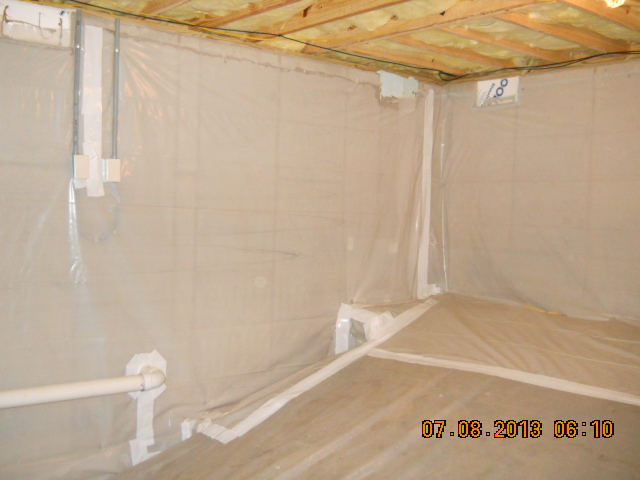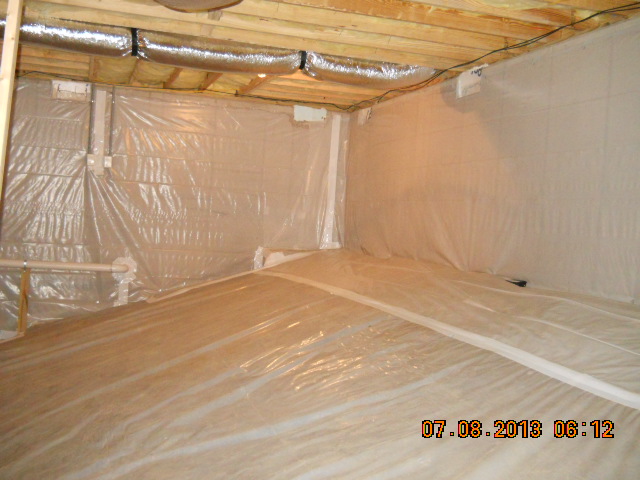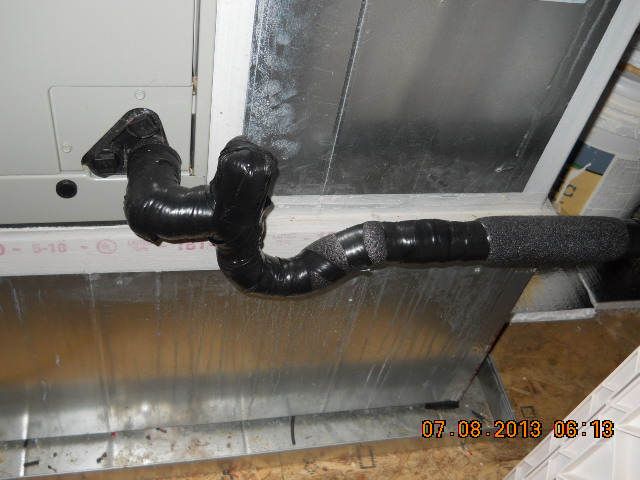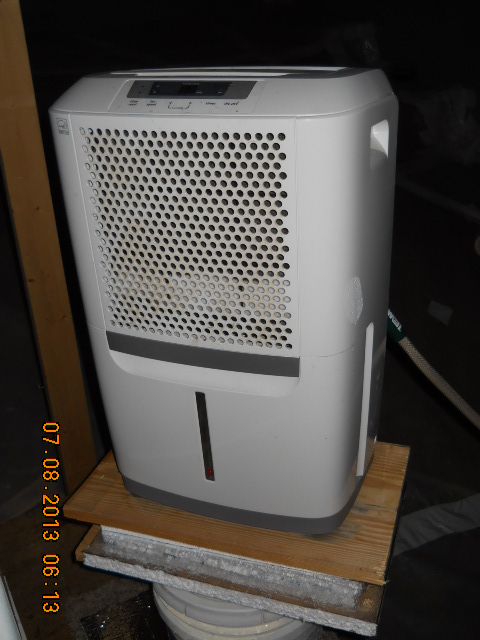Encapsulating your crawlspace is one of the most important advances in design and construction technology in the last 400 years. It keeps your crawlspace and your entire house cleaner, healthier, drier, nearly 99% pest free and more energy efficient. And: it feels better and looks better.
Why are the HOME ARCHITECTS ® talking about this? Because this is just one more of the long list of features they design into their projects to help their clients have better, healthier, cleaner and more energy efficient houses. And the cost can be minimal. Read on to find out what this new, excellent approach to crawlspace treatment is and how it can help you and your existing or proposed new house to function better.
What is CRAWLSPACE ENCAPSULATION ? It is taking large rolls of either white vinyl or white or black or clear polyethylene and completely coating your crawlspace earth and foundation walls with the plastic. This Architect prefers white, as it is more light reflective and allows you clearly see everything in this space, which normally does not have many sources of lighting.
Why encapsulate? To block the humidity, dampness and critters that are in the earth and coming through walls from getting into your house.
Building code requires that you have a “vapor barrier” over the earth in a crawlspace, but it does Not require that the foundation walls be covered, nor does it specify the exact manner in which the vapor barrier is to be installed. For instance, Rand Soellner, Architect, ArCH, NCARB, LHI, Senior Staff Architect of the aforementioned company, said that: “I also happen to be a licensed Home Inspector, as well as a licensed Architect. When I inspect existing houses, there are very few standing residential crawlspaces that have a continuous vapor barrier. Normally it is all torn up, moved, wadded together, with large, gaping holes and lots of exposed, wet dirt in the crawlspace. I see mice, rats, spiders, ants, cockroaches, termites, flowing water, even racoons in many peoples’ crawlspaces. It’s a zoo down there.”
Soellner’s point is that minimum code will NOT protect owners either during construction or after. Click here for more information on –> Minimum Code.
“You need a licensed Architect to design and specify and observe the construction of a house to insure that this situation doesn’t happen. An exposed earthen crawlspace, just about guarantees that you will have mice, ants, cockroaches, excessive humidity, mold, rot and that horrible moldy smell…” All of which can make living and selling an existing house troublesome. People subconsciously trust what their noses tell them, just like when they are eating food. If it smells bad: No Sale. And if you see mice and bugs: forget it.

So how does encapsulation work? How is it accomplished? Soellner’s firm specifies the particulars, to make sure that there are no questions about how the contractor is to go about it. One of the most important aspects: NO ventilation of the crawlspace from normal through-wall crawlspace vents. That’s one of the major sources of Arctic air in winter, which increases your utility bills, and also permits nearly 100% humidity into your crawlspace during muggy summers. Also those vents are where some of the pests can enter.
Better to not have the crawlspace vents at all. The HOME ARCHITECTS ® indicate that there are to be none, when building from scratch. If you already have crawlspace vents, it’s not the end of the world. You can simply seal them off, usually from the rear, and sometimes both sides. They should be closed, then taped shut, with rigid insulation tightly fit to the interior side, and liquid foam should seal minor existing gaps. Note: regarding radon: this firm always specifies an option for a radon gas removal system, which would have its piping under the crawlspace encapsulation, with the vent fans exhausting to the outside.
The earth floor of the crawlspace needs to be cleaned of all wood and construction debris. That is food to bugs. So that needs to be removed from your house and disposed of at a landfill.
The earth floor should be reasonably smooth. Quite often it slopes with the natural terrain.

There should be a drain at the low point(s) of the earth. This should be a manufactured drain grate, connected to plastic drain pipe, which comes down and outside of the foundation wall. At the end, there should be another slotted drainage grate (to keep out mice and large pests), and there should also be insect screen to keep out bugs. This level of detail is normally Not adhered to when you do not have a licensed Architect designing your project. It is highly recommend that you have a real Architect designing and specifying your house so that details like this are covered. Things like this are critical to providing and maintaining a clean and healthy house. The reason for this drain(s) is to make sure that any water in the earth can drain down and out of the crawlspace so that it can be and remain dry and free of mold and mildew. Water in a crawlspace is the enemy, along with creepy-crawlies. Your Architect will details and specify conditions to help keep your crawlspace clean, dry and pest-free. This drainline should extend down and away from the house at least 24″ from the foundation wall, and perhaps more. It should not conduct flowing water near to or over or around foundations for posts, walls, or over septic fields.
Next, the actual encapsulation begins: your vapor barrier is laid down over the earth. This is done in large, wide, smooth runs of polyethylene (if you are doing this on the cheap), or with white, thick vinyl (if you are doing this in the best manner). The runs of vapor barrier are overlapped next to each other. 100% of the joints are taped, with white vinyl tape. No gaps permitted anywhere. The runs of vapor barrier are curved up the walls, covering the entire foundation wall height, up to within 3″ of the underside of wood framing (to act as a termite inspection gap). Once again, ALL of the joints of vapor barrier are taped.
Also: a quality job uses a construction adhesive that is chemically compatible with the vapor barrier, to provide a continuous seal between the vapor barrier and the top area of the wall, to keep out (can you guess?): moisture and pests. The vapors from the construction adhesive are quite pungent and no one should be in the house for at least 48 hours after this has been accomplished and the work area should be well ventilated with power fans.
Plastic-capped power driven nails that can penetrate concrete are used to secure the various stress locations of vapor barrier into place. Also, all penetrations in the floor and walls are surrounded with white vinyl tape. Sometimes small nails need to be used to keep the tape in place around certain surfaces to which the tape may not adhere to well.

There are several other features in the HOME ARCHITECTS ® treatment of crawlspaces to complete a treatment. The specify that all HVAC (Heating, Ventilating, Air-Conditioning) AHU (Air Handler Unit) condensate drainlines be insulated with synthetic insulation. This prevents water vapor in the air in the crawlspace from condensing on this cold pipe, and therefore prevents dripping water from occurring in the crawlspace along condensate drainlines. Once again: water in the Crawlspace is the enemy of a clean, dry, healthy house. This type of drainline should extend at least 18″ beyond the face of the foundation wall above grade, and be at least 12″ above exterior earth level. You do not want this steady dripping to undermine any footings and you do not want to give access into the equipment for pests. Everything is connected. Your Architect is thinking about all of these things when planning and designing your house, which is one of the reasons you hired them: to provide you with a better, cleaner, safer and more energy efficient residence. This architectural firm also recommends at least one additional stand-up fan that is constantly on, to push air in the Crawlspace around, and not become stagnant, generally near the AHU, to insure that little, if any humidity condenses on its surface, to prevent corrosion of its metal components.

You also will need an automatic, hard-piped dehumidifier running in the Crawlspace. ALL of the time. Never turn it off. Check it once a week to make sure that a power outage didn’t accidentally turn it off. This will be your insurance and your main policeman, protecting you against humidity in your Crawlspace. The dehumidifier will continuously squeeze and drain any humidity in your atmosphere in the Crawlspace and drain it to the outside world. You want this drainline to also extend at least 18″ or more beyond your foundation wall, so that this constantly dripping water doesn’t erode or undermine your wall footings. Make sure that the drainline is installed by a licensed plumber and that it slopes down and out of your house.
If you have a licensed Architect design your house, one familiar with such matters, your house will smell clean, because it will be clean. Your house will be drier, which means that your air-conditioning won’t have to work as hard, which saves you money from your monthly power bill. And: few, if any bugs or other pests will be able to gain access into your hosue. Rand Soellner commented: “We are Terminix’s favorite. Jim, our quarterly pest inspector, says he never sees any bugs, rodents, nothing in the Crawlspace or in the house. His job is easy. And, neither do we, up in the house above. Also, our home smells like good, clean wood. Never any musty odors. Encapsulating our Crawlspace has made our house a health, energy efficient home.”
To have a new house or existing residence created with an Encapsulated Crawlspace for you, give a call or e-mail to: Rand@HomeArchitects.com 828-269-9046. www.HomeArchitects.com
tags: encapsulated crawlspace, cashiers, atlanta, new orleans, aspen, telluride, highlands, asheville, hendersonville, newnan, las vegas, los angeles, timber frame, post and beam
